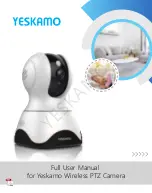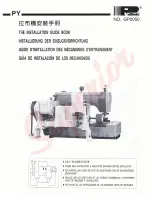
Now you can try different positions for the plate and the camera/lens you are using to find a good balance
point on the head. Start in the center, tighten the Quick Release Knob (3) and check the balance of the rig with
the head's Drag Control (5) loose. If the rig is not well balanced, loosen the Quick Release Knob (3) slightly,
slide the camera forward or back a bit, tighten the knob and test the balance again. Repeat this process until
you have the best balance point. Now, look at the scale next to the plate and record the number the plate
marker is pointing to. You can use this to quickly set up the same camera and lens combination again in the
future.
Warning: always have a hand on your camera when you loosen the Quick Release Knob to prevent
accidental dropping and damage
.
TRIPOD OPERATION
Adjusting and extending the legs
Unhook the Leg Connection Clip (13) and pull out on all of the legs to form the basic tripod. Notice the
Spreader (11). It adds stability to your tripod. There are 3 Spreader Levers (12), which can be opened. When
they are opened you can further stretch the legs out into a wider stance. This wider stance, with the Spreader
(11) fully extended, is the most stable position for your tripod kit, regardless of the height you are using.
To extend the length of any leg twist the Leg Lock (9) counterclockwise, extend that particular leg section,
and then tighten the Leg Lock (9) by turning it clockwise until it stops. Each leg section can be adjusted to
any position along its length. This way you can adjust each leg differently over uneven ground to make the
tripod level. A level tripod will be the safest and most stable way to shoot.
Using the bowl adapter
Loosen the Bowl Handle (10) slightly. Grasp the CH60 head and move it around on the bowl adapter to find a
level position. Watch the bubble level on the lower part of the head to guide your positioning. Once you have
found a level point, hold the head in place and tighten the Bowl Handle (10).
Using the CH60 Cine head
With your camera mounted to the CH60 head loosen the Panning Control Knob (8) to allow a side-to-side,
rotational movement of the head and camera or tighten it in place to avoid accidental side-to-side movement.
Notice the panning action of the head is smooth. Practice making soft starts and stops to your panning
movements to achieve professional looking results.
Two knobs control the tilting motion of the CH60 head. The Tilt Control Knob (7) can be loosened to allow a
tilting motion forward and back for the head and your camera. Tighten the Tilt Control Knob (7) to keep the
camera in place. The Drag Control (5) allows the tilting motion to be controlled for the weight of the
particular camera and lens you are using. Turn the Drag Control (5) towards its + or - side to tighten or loosen
the drag. Once you find the best amount of drag for your camera you can use the Tilt Control Knob (7) to turn
on or off the tilt control all together. The head will keep the same drag amount as you use the Tilt Control
Knob (7). Similar to the panning control, practice soft starts and stops to your tilting motion.
You may choose to loosen the panning and tilting control at the same time. This is a situation in which using
two hands on both handles can be extremely helpful for the best control of your camera. The more you
practice soft starts, soft stops, and smooth, even motion with your CH60 head, the better your video footage
will become.
Using the accessory port
One 3/8
”
threaded, female Accessory Port (2) is located in the CH60 head. Use this to connect accessories
such as flex arms, spigots, etc. With these accessories mounted you can hold an item such as an external video
monitor or LED light. Whatever you connect will move with your camera as you control the CH60 head.
Содержание Cine Tripod CT60K
Страница 4: ......






















